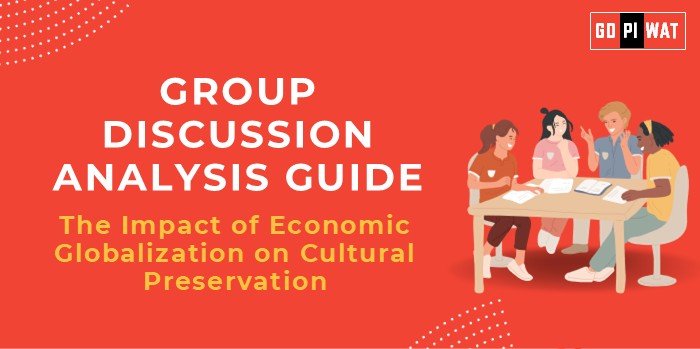📋 Group Discussion Analysis Guide
🌍 The Impact of Economic Globalization on Cultural Preservation
💡 Introduction to the Topic
🌱 Opening Context: Economic globalization has interconnected nations through trade, investment, and cultural exchange. While it has driven economic progress and cross-border collaboration, concerns about its influence on cultural preservation remain critical.
📜 Topic Background: Economic globalization has its roots in the late 20th century, driven by technological advancements, free trade agreements, and multinational corporations. While it facilitates cultural exchange, there is apprehension about homogenization and the potential erosion of traditional identities.
📊 Quick Facts and Key Statistics
- 📈 Global Trade Volume: $32 trillion in 2022, reflecting the interconnected global economy.
- 🌐 UNESCO Data: Over 40% of the world’s languages are at risk of extinction, partly due to cultural homogenization.
- 💰 Cultural Tourism Revenue: $1.8 trillion globally in 2023, showing demand for preserved cultural heritage.
- 🎥 Media Dominance: Hollywood accounts for 60% of global box office revenues, exemplifying cultural hegemony.
🌍 Stakeholders and Their Roles
- 🏛️ Governments: Enforce cultural policies and protect heritage sites.
- 🏢 Multinational Corporations: Balance profit with respecting local traditions.
- 🌐 NGOs and Cultural Institutions: Advocate for and implement preservation initiatives.
- 👥 Communities: Act as custodians of their cultural heritage.
🏆 Achievements and Challenges
🌟 Achievements:
- 🌏 Cultural Revival Projects: UNESCO has successfully preserved 1,157 World Heritage Sites.
- 🍴 Global Cuisine Fusion: Local cuisines gain international recognition, fostering cultural pride.
- 🤝 Cultural Exchange Programs: Increase understanding and mutual respect.
- 💻 Digital Documentation: Efforts like Google Arts & Culture archive global traditions for future generations.
⚠️ Challenges:
- 🌍 Cultural Homogenization: Western cultural dominance in media and entertainment.
- 📉 Economic Pressures: Communities prioritizing economic growth over tradition.
- 🔤 Language Erosion: Half of the world’s languages risk extinction by 2100.
🌍 Global Comparisons:
- 🇨🇳 China: Promotes traditional arts like Beijing opera while integrating modern media.
- 🇫🇷 France: Enforces quotas on non-French media content to preserve its culture.
📜 Case Studies:
- 🇮🇳 India’s Yoga Diplomacy: Showcases how cultural heritage can be leveraged globally while preserving authenticity.
✨ Structured Arguments for Discussion
- 💬 Supporting Stance: “Economic globalization enriches cultures by promoting diversity and exchange.”
- ⚖️ Opposing Stance: “Globalization erodes local identities, prioritizing economic gain over cultural values.”
- 🔄 Balanced Perspective: “While globalization brings opportunities for cultural exchange, proactive measures are essential to protect local traditions.”
🎯 Effective Discussion Approaches
📖 Opening Approaches:
- 📊 Use data: “With globalization contributing $32 trillion to trade, it challenges nations to protect unique cultures amidst growth.”
- ⚡ Highlight issues: “Globalization’s impact on 40% of endangered languages calls for urgent policy interventions.”
🔄 Counter-Argument Handling:
- 🤝 Recognize economic benefits while emphasizing strategies to safeguard traditions.
- 🌍 Present global successes like UNESCO’s preservation efforts as counterpoints to cultural homogenization.
📈 Strategic Analysis of Strengths and Weaknesses
- 💪 Strengths: Cultural exchange, global reach for local traditions.
- ⚠️ Weaknesses: Risk of homogenization, economic overshadowing of traditions.
- 💡 Opportunities: Leverage technology for cultural documentation.
- 🚨 Threats: Loss of intangible heritage due to commercialization.
📚 Connecting with B-School Applications
- 🌟 Real-World Applications: Case studies on balancing economic and cultural objectives in operations or marketing.
- 💬 Sample Interview Questions:
- “How can multinational firms contribute to cultural preservation?”
- “What policies can governments adopt to balance globalization with cultural conservation?”
- 📖 Insights for Students:
- Recognize the role of sustainable business practices in cultural preservation.
- Understand the interplay between economic growth and cultural conservation.


